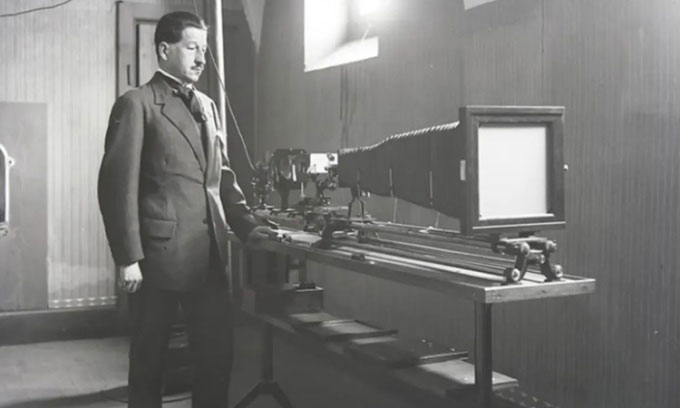Real life Sherlock Homes forensics lab
Edmond Locard, nicknamed the French Sherlock Holmes, built the world's first forensic laboratory in Lyon .

Edmond Locard uses a photographic equipment in the 1920s. (Photo: Lyon Archives)
A collection of more than 20,000 photographic plates was discovered in a garage in the city of Lyon in France in 2005. At that time, authorities did not have the budget to reconstruct the photos. Funding from a local historian in 2017 helped preserve and digitalize more than two-thirds of this collection. The results reveal that the world's first investigative laboratory was created in 1910 by forensic science pioneer Edmond Locard, nicknamed the French Sherlock Holmes, Interesting Engineering reported on April 8.
Going to the scene and piecing together clues to recreate the crime sequence is very popular in today's crime investigation. But a century ago, police did not investigate cases like they do today. Handwriting analysis was considered an advanced technique and through it, Locard began his career in forensics.
Locard's instructor Alphonse Bertillon invented a method of identifying people, using body measurements . But when a Jewish officer was accused of espionage, Bertillon was called in as a handwriting expert, even though he had no experience in this field. Bertillion's false testimony contributed to the famous police scandal known as the Dreyfus affair. This event also prompted Locard to build a laboratory where fingerprints, blood samples, hair, dust and pollen could all be scientifically analyzed for use as evidence in court.
Collection of photographic plates from the laboratory located in the garage of the National Forensic Police Department in Ecully, Lyon, until 2005. Despite being moved to archives in the city, these photographic plates continued to deteriorate. over the next decade due to lack of resources. In 2017, the thin layer of gelatin in the photos was contaminated with mold. It was not until burial historian Nicolas Delestre provided financial support that the restoration of the photograph took place. The photos were digitized and completed in the spring of 2018 as a biography of Locard was prepared for publication.
Up to now, photos published show Locard's team working with the device and conducting experiments. One of the ways they use to identify people is by classifying body tattoos. Locard's inspirations include the Lumière brothers, pioneers of cinematography, and Arthur Conan Doyle, father of Sherlock Holmes. During his life, Locard also stopped using some techniques such as handwriting analysis because he considered the results unreliable. Locard's forensic research more than a century ago can inspire experts today. A detailed description of Locard's forensic lab photos was shared in the journal Nature.
- Thinking like Sherlock Holmes
- Observe, deduce - Sherlock Holmes skills and ways to get them
- You have logical thinking just like Sherlock Holmes if you do all these 6 puzzles
- What happens if a zombie pandemic appears in real life?
- Seeing the scowl is seen as a real-life Angry Bird version
- Armadillo Lizard - Dragons in real life
- The difference between the killer in the movie and the real life
- 'Cast' hero from the game
- Best news aggregation for June 1 week
- Dating online - the journey of the uncle
- The dark, little-known life of Mona Lisa in real life
- 'Real death' in the virtual world
 The most famous scientific failures in history
The most famous scientific failures in history Mysterious genius mechanic and the machine froze time
Mysterious genius mechanic and the machine froze time The son carries the 'bad gene' of genius Albert Einstein
The son carries the 'bad gene' of genius Albert Einstein Isaac Newton
Isaac Newton